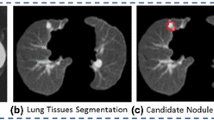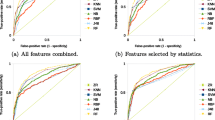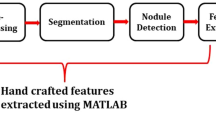Abstract
The aim of this paper is to examine a multiclassifier approach to the classification of the lung nodules in X-ray chest radiographs. The approach investigated here is based on an image region-based classification whose output is the information of the presence or absence of a nodule in an image region. The classification was made, essentially, in two steps: firstly, a set of rotation invariant features was extracted from the responses of a multi-scale and multi-orientation filter bank; secondly, different classifiers (multi-layer perceptrons) are designed using different features sets and trained in different data. These classifiers are further combined in order to improve the classification performance. The obtained results are promising and can be used for reducing the false-positives nodules detected in a computer-aided diagnosis system.
Access this chapter
Tax calculation will be finalised at checkout
Purchases are for personal use only
Preview
Unable to display preview. Download preview PDF.
Similar content being viewed by others
References
Jemal, A., Murray, T., Ward, E., Samuels, A., Tiwari, R.C., Ghafoor, A., Feuer, E.J., Thun, M.J.: Cancer Statistics. Cancer J.Clin. 55, 10–30 (2005)
Keserci, B., Yoshida, H.: Computerized detection of pulmonary nodules in chest radiographs based on morphological features and wavelet snake model. Medical Image Analysis 6, 431–447 (2002)
van Ginneken, B., Romeny, B.M.H., Viergever, M.A.: Computer-aided diagnosis in chest radiography: A survey. IEEE Transactions on Medical Imaging 20(12), 1228–1241 (2001)
Wei, J., Hagihara, Y., Shimizu, A., Kobatake, H.: Optimal image feature set for detecting lung nodules on chest X-ray images. In: CARS 2002 (2002)
van Ginneken, B., Katsuragawa, S., ter Haar Romeny, B.M., Kunio, D., Viergever, M.A.: Automatic detection of abnormalities in chest radiographs using local texture analysis. IEEE Transactions on Medical Imaging 21, 139–149 (2002)
Schilham, A.M.R., van Ginneken, B., Loog, M.: Multi-scale Nodule Detection in Chest Radiographs. In: Ellis, R.E., Peters, T.M. (eds.) MICCAI 2003. LNCS, vol. 2878, pp. 602–609. Springer, Heidelberg (2003)
Shiraishi, J., Katsuragawa, S., Ikezoe, J., Matsumoto, T., Kobayashi, T., Komatsu, K.-i., Matsui, M., Fujita, H., Kodera, Y., Doi, K.: Development of a Digital Image Database for Chest Radiographs With and Without a Lung Nodule: Receiver Operating Characteristic Analysis of Radiologists Detection of Pulmonary Nodules. American Journal of Roentgenology 174, 71–74 (2000)
Yoshida, H.: Local contralateral subtraction based on bilateral symmetry of lung for reduction of false positives in computerized detection of pulmonary nodules. IEEE Transactions on Biomedical Engineering 51, 778–789 (2004)
Suzuki, K., Shiraishi, J., Abe, H., MacMahon, H., Doi, K.: False-positive reduction in computer-aided diagnostic scheme for detecting nodules in chest radiographs by means of massive training artificial neural network. Academic Radiology 12, 191–201 (2005)
Randen, T., Husoy, J.H.: Filtering for texture classification: A comparative study. IEEE Transactions on Pattern Analysis and Machine Intelligence 21(4) (1999)
Grigorescu, S.E., Petkov, N., Kruizinga, P.: Comparison of texture features based on Gabor filters. IEEE Transactions on Image Processing 11(10), 195–203 (2002)
Kumar, A., Pang, G.K.H.: Defect detection in textured materials using Gabor filters. IEEE Transactions on Industry Applications 38(2) (2002)
Varma, M., Zisserman, A.: Unifying statistical texture classification frameworks. Image and Vision Computing 22, 1175–1183 (2004)
Leung, T., Malik, J.: Representing and recognizing the visual appearance of materials using three-dimensional textons. International Journal of Computer Vision 43, 29–44 (2001)
Alexandre, L.A., Campilho, A.C., Kamel, M.: On combining classifiers using sum and product rules. Pattern Recognition Letters 22, 1283–1289 (2001)
Author information
Authors and Affiliations
Editor information
Editors and Affiliations
Rights and permissions
Copyright information
© 2006 Springer-Verlag Berlin Heidelberg
About this paper
Cite this paper
Pereira, C.S., Alexandre, L.A., Mendonça, A.M., Campilho, A. (2006). A Multiclassifier Approach for Lung Nodule Classification. In: Campilho, A., Kamel, M. (eds) Image Analysis and Recognition. ICIAR 2006. Lecture Notes in Computer Science, vol 4142. Springer, Berlin, Heidelberg. https://doi.org/10.1007/11867661_55
Download citation
DOI: https://doi.org/10.1007/11867661_55
Publisher Name: Springer, Berlin, Heidelberg
Print ISBN: 978-3-540-44894-5
Online ISBN: 978-3-540-44896-9
eBook Packages: Computer ScienceComputer Science (R0)




